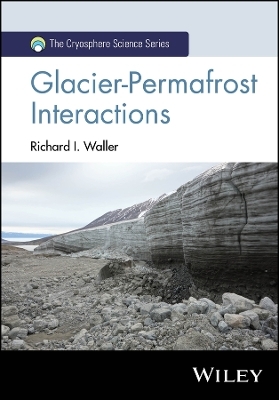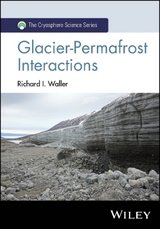Glacier-Permafrost Interactions
John Wiley & Sons Inc (Verlag)
9781118620984 (ISBN)
A systematic exploration of the interactions between glaciers and permafrost
In Glacier-Permafrost Interactions, experienced glaciologist Richard I. Waller delivers a comprehensive discussion of the interactions between glaciers and permafrost. The book is highly relevant to contemporary debates regarding ongoing recession of glaciers and the degradation of permafrost in the face of global warming. By integrating modern-era observations with findings from Quaternary science, this book demonstrates how glaciers and permafrost can interact and behave as an integrated system.
This summary of the current thinking and emerging research on glacier-permafrost interaction also provides:
- Comprehensive discussions of permafrost in modern and ancient glacial environments
- A focused review of the distinctive characteristics of glaciers found in permafrost environments
- An integrated overview of the nature and impacts of glacier-permafrost interactions on the hydrology and dynamic behaviour of glaciers and their landscape expression
- A survey of current research efforts and future directions in the field
Richard I. Waller is a Senior Lecturer in Physical Geography at Keele University (United Kingdom).
Author Biography x
Preface xi
Acknowledgements xiii
1 Introduction 1
1.1 Research Context and Academic Background 1
1.2 Overview of the Significance of Glacier–Permafrost Interactions 3
1.3 Explanation of the Book Structure 6
References 7
2 Permafrost in Modern and Ancient Glacial Environments 9
2.1 Introduction 9
2.2 Thermal and Physical Properties 9
2.2.1 Defining Characteristics 9
2.2.2 Water in Permafrost 12
2.2.3 Ground Ice 15
2.3 The Formation and Preservation of Permafrost 19
2.3.1 Subaerial Permafrost 19
2.3.2 Subglacial Permafrost 21
2.4 The Distribution and Spatial Extent of Permafrost 26
2.4.1 The Modern Day and Last Glacial Maximum Distribution of Permafrost 26
2.4.2 The Spatial Distribution of Contemporary Permafrost 27
2.4.3 Temporal Changes in the Extent of Subglacial Permafrost 34
2.5 Permafrost Rheology 37
2.5.1 The Rheology of Ice, Sediment and Ice–Sediment Mixtures 37
2.5.2 The Rheology of Subglacial Permafrost 44
2.6 Summary 45
References 46
3 Glaciers and Glacial Processes in Permafrost Environments 53
3.1 Introduction 53
3.2 Thermal Regimes of Glaciers and Permafrost 54
3.3 Basal Boundary Conditions and Processes 60
3.3.1 Introduction 60
3.3.2 Rigid-Bed Glaciers and Basal Sliding 62
3.3.3 Soft-Bed Glaciers and Subglacial Sediment Deformation 63
3.4 ‘Frozen Beds’ and Traditional Glaciological Models 65
3.4.1 Frozen Beds and the Operation of Basal Processes 65
3.4.2 Thermal Controls on the Processes of Subglacial Erosion 67
3.5 Active Subglacial Processes at Sub-Freezing Temperatures – An Emerging Paradigm? 71
3.5.1 Early Experimental Studies 71
3.5.2 Direct Observations of Basal Processes Beneath Cold-Based Glaciers 72
3.5.3 Active Erosion and Debris Entrainment at Sub-Freezing Temperatures 75
3.5.4 Formation of Debris-Rich Basal Ice 78
3.5.5 Effective Beds and Dynamic Soles – Insights from Formerly Glaciated Environments 86
3.6 Ice-Marginal and Proglacial Processes 89
3.6.1 Introduction 89
3.6.2 Apron Entrainment 89
3.6.3 Proglacial Thrusting 92
3.6.4 The Deposition and Preservation of Ice Within Proglacial Environments 94
3.7 Summary 96
References 97
4 Hydrology, Dynamics and Sediment Fluxes 107
4.1 Introduction 107
4.2 The Hydrology of Non-Temperate Glaciers 107
4.2.1 Introduction 107
4.2.2 Seasonal Variations 109
4.2.3 Drainage Pathways 114
4.2.4 Suspended-Sediment and Solute Fluxes 120
4.2.5 Glacial Groundwater Fluxes in Permafrost Environments 125
4.3 The Dynamic Behaviour of Non-Temperate Glaciers 132
4.3.1 Introduction 132
4.3.2 Modern-Day Non-Temperate Glaciers 133
4.3.3 Ice-Sheet Flow and Ice-Stream Dynamics 144
4.3.4 Pleistocene Ice Sheets and Cold-Based Ice 148
4.4 Sediment Fluxes Within Glaciated Permafrost Catchments 149
4.5 Summary 155
References 157
5 The Landscape Expression of Glacier–Permafrost Interactions: Landforms, Sediments and Landsystems 163
5.1 Introduction 163
5.2 Cold-Based Glaciers and Glacial Protectionism 164
5.3 Specific Landforms Related to Cold-Based Glaciers and Glacier–Permafrost Interactions 173
5.3.1 Lateral Meltwater Channels 173
5.3.2 End Moraines 176
5.3.2.1 Ice-Cored Moraines 178
5.3.2.2 Push Moraines, Thrust Moraines and Composite Ridges 183
5.3.3 Subglacial Landforms 189
5.3.4 Massive Ground Ice 195
5.3.5 Icings, Pingos and Blowouts 200
5.4 Sedimentological and Structural Evidence for Glacier–Permafrost Interactions 203
5.4.1 The Influence of Thermal Regime on the Sedimentology of Glacigenic Debris 203
5.4.2 Rafts, Intraclasts and Hydrofractures 209
5.4.3 The Glacitectonic Deformation of Permafrost 213
5.5 Glacial Landsystem Models 222
5.5.1 Process-Form Models and Glacial Landsystems 222
5.5.2 Pleistocene Ice Sheets 226
5.5.3 Arctic Glacial Landsystems 235
5.5.4 Cold Extremes – Antarctic Glacial Landsystems 238
5.5.5 Martian Landsystems 242
5.6 Glaciers, Permafrost and Paraglaciation 246
5.6.1 Introduction 246
5.6.2 Rock Slope Failure 250
5.6.3 Thermokarst, Dead Ice and Megaslumps 253
5.7 Summary 262
References 265
6 Future Research Directions 279
6.1 Basal Boundary Conditions and Processes Beneath Cold-Based Glaciers 279
6.2 The Rheology of Subglacial Permafrost 281
6.3 Using Geomorphological Evidence to Reconstruct Basal Thermal Regime 283
6.4 Sedimentological and Structural Criteria for Identifying Glacier–Permafrost Interactions 285
6.5 Determining the Influence of Permafrost on Glacier Dynamics 288
6.6 Glacier–Permafrost Interactions and Future Climate Change 290
6.7 Towards an Integrated Analysis of Glaciers and Permafrost 293
References 294
Index 301
| Erscheinungsdatum | 01.04.2022 |
|---|---|
| Reihe/Serie | The Cryosphere Science Series |
| Verlagsort | New York |
| Sprache | englisch |
| Maße | 173 x 246 mm |
| Gewicht | 748 g |
| Einbandart | gebunden |
| Themenwelt | Naturwissenschaften ► Biologie ► Ökologie / Naturschutz |
| Naturwissenschaften ► Geowissenschaften ► Geologie | |
| ISBN-13 | 9781118620984 / 9781118620984 |
| Zustand | Neuware |
| Informationen gemäß Produktsicherheitsverordnung (GPSR) | |
| Haben Sie eine Frage zum Produkt? |
aus dem Bereich




